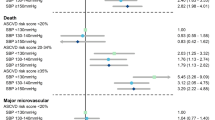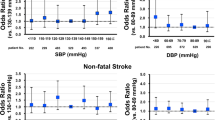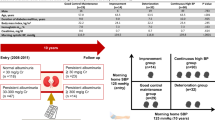Abstract
Diabetes mellitus often develops in patients with hypertension. We investigated predictors of diabetes mellitus development in hypertensives at risk of developing the disease in the VALUE trial population. Among the 9995 non-diabetic hypertensive patients at baseline, 1298 patients developed diabetes mellitus during the average follow-up of 4.2 years. New-onset diabetes mellitus was defined from adverse event reports, information about new antidiabetic medication and/or a fasting glucose ⩾7.0 mmol l−1 at the end of trial. Twenty-five potential baseline predictors of new-onset diabetes mellitus were analysed by univariate logistic regression and 14 of 25 predictors were found to be statistically significant with a P-value <0.05. The predictors were in order of decreasing significance; glucose, body mass index (BMI), age, uric acid, non-Caucasian race, haemoglobin, heart rate, randomized study treatment, history of coronary heart disease (CHD), gender, total cholesterol, proteinuria, potassium and creatinine. Multivariate stepwise logistic regression analyses were used and potential baseline predictors of new-onset diabetes mellitus were considered significant by four different models (P-value <0.001). The final multivariate model selected included all patients, but not treatment group as a potential predictor, and the six significant predictors identified from this model were glucose, BMI, non-Caucasian race, age, heart rate and history of CHD. In conclusion, glucose and BMI were the most important predictors of new-onset diabetes mellitus in hypertensive patients at high cardiovascular risk, and easily accessible clinical characteristics strongly predict patients at risk of developing diabetes mellitus.
This is a preview of subscription content, access via your institution
Access options
Subscribe to this journal
Receive 12 digital issues and online access to articles
$119.00 per year
only $9.92 per issue
Buy this article
- Purchase on Springer Link
- Instant access to full article PDF
Prices may be subject to local taxes which are calculated during checkout
Similar content being viewed by others
References
Howard BV, Rodriguez BL, Bennett PH, Harris MI, Hamman R, Kuller LH et al. Prevention Conference VI: Diabetes and Cardiovascular disease: Writing Group I: epidemiology. Circulation 2002; 105: e132–e137.
Lindholm LH, Ibsen H, Borch-Johnsen K, Olsen MH, Wachtell K, Dahlöf B et al. Risk of new-onset diabetes in the Losartan Intervention For Endpoint reduction in hypertension study. J Hypertens 2002; 20: 1879–1886.
Niklason A, Hedner T, Niskanen L, Lanke J . Development of diabetes is retarded by ACE inhibition in hypertensive patients—a subanalysis of the Captopril Prevention Project (CAPPP). J Hypertens 2004; 22: 645–652.
Mann J, Julius S . The Valsartan Antihypertensive Long-term Use Evaluation (VALUE) trial of cardiovascular events in hypertension. Rationale and design. Blood Press 1998; 7: 176–183.
Kjeldsen SE, Julius S, Brunner H, Hansson L, Henis M, Ekman S et al. Characteristics of 15,314 hypertensive patients at high coronary risk. The VALUE trial. The Valsartan Antihypertensive Long-term Use Evaluation. Blood Press 2001; 10: 83–91.
Julius S, Kjeldsen SE, Weber M, Brunner HR, Ekman S, Hansson L et al. Outcomes in hypertensive patients at high cardiovascular risk treated with regimens based on valsartan or amlodipine: the VALUE randomised trial. Lancet 2004; 363: 2022–2031.
WHO. Diabetes mellitus. Report of a WHO Study Group. World Health Organ Tech Rep Ser 1985; 727: 1–113.
Alberti KG, Zimmet PZ . Definition, diagnosis and classification of diabetes mellitus and its complications. Part 1: diagnosis and classification of diabetes mellitus provisional report of a WHO consultation. Diabet Med 1998; 15: 539–553.
Weber MA, Julius S, Kjeldsen SE, Brunner HR, Ekman S, Hansson L et al. Blood pressure dependent and independent effects of antihypertensive treatment on clinical events in the VALUE Trial. Lancet 2004; 363: 2049–2051.
Genuth S . Lowering the criterion for impaired fasting glucose is in order. Diabetes Care 2003; 26: 3331–3332.
Stern MP, Williams K, Haffner SM . Identification of persons at high risk for type 2 diabetes mellitus: do we need the oral glucose tolerance test? Ann Intern Med 2002; 136: 575–581.
Tirosh A, Shai I, Tekes-Manova D, Israeli E, Pereg D, Shochat T et al. Normal fasting plasma glucose levels and type 2 diabetes in young men. N Engl J Med 2005; 353: 1454–1462.
Boden G . Role of fatty acids in the pathogenesis of insulin resistance and NIDDM. Diabetes 1997; 46: 3–10.
Lam TK, Pocai A, Gutierrez-Juarez R, Obici S, Bryan J, Aguilar-Bryan L et al. Hypothalamic sensing of circulating fatty acids is required for glucose homeostasis. Nat Med 2005; 11: 320–327.
Wei M, Gaskill SP, Haffner SM, Stern MP . Waist circumference as the best predictor of noninsulin dependent diabetes mellitus (NIDDM) compared to body mass index, waist/hip ratio and other anthropometric measurements in Mexican Americans—a 7-year prospective study. Obes Res 1997; 5: 16–23.
Stevens J, Couper D, Pankow J, Folsom AR, Duncan BB, Nieto FJ et al. Sensitivity and specificity of anthropometrics for the prediction of diabetes in a biracial cohort. Obes Res 2001; 9: 696–705.
Olsen MH, Fossum E, Hjerkinn E, Wachtell K, Höieggen A, Nesbitt SD et al. Relative influence of insulin resistance versus blood pressure on vascular changes in longstanding hypertension. ICARUS, a LIFE sub-study. Insulin Carotids US Scandinavia. J Hypertens 2000; 18: 75–81.
Lipton RB, Liao Y, Cao G, Cooper RS, McGee D . Determinants of incident non-insulin-dependent diabetes mellitus among blacks and whites in a national sample. The NHANES I Epidemiologic Follow-up Study. Am J Epidemiol 1993; 138: 826–839.
Resnick HE, Valsania P, Halter JB, Lin X . Differential effects of BMI on diabetes risk among black and white Americans. Diabetes Care 1998; 21: 1828–1835.
Conn JW . Hypertension, the potassium ion and impaired carbohydrate tolerance. N Engl J Med 1965; 273: 1135–1143.
Julius S, Gudbrandsson T, Jamerson K, Tariq SS, Andersson O . The hemodynamic link between insulin resistance and hypertension. J Hypertens 1991; 9: 983–986.
Ligtenberg G, Blankestijn PJ, Oey PL, Klein IH, Jkhorst-Oei LT, Boomsma F et al. Reduction of sympathetic hyperactivity by enalapril in patients with chronic renal failure. N Engl J Med 1999; 340: 1321–1328.
Kjeldsen SE, Julius S, Mancia G, McInnes GT, Hua T, Weber MA et al. Effects of valsartan compared to amlodipine on preventing type 2 diabetes in high-risk hypertensive patients: the VALUE trial. J Hypertens 2006; 24: 1405–1412.
Dahlöf B, Devereux RB, Kjeldsen SE, Julius S, Beevers G, de Faire U et al. Cardiovascular morbidity and mortality in the Losartan Intervention For Endpoint reduction in hypertension study (LIFE): a randomised trial against atenolol. Lancet 2002; 359: 995–1003.
Hansson L, Lindholm LH, Niskanen L, Lanke J, Hedner T, Niklason A et al. Effect of angiotensin-converting-enzyme inhibition compared with conventional therapy on cardiovascular morbidity and mortality in hypertension: the Captopril Prevention Project (CAPPP) randomised trial. Lancet 1999; 353: 611–616.
Freeman DJ, Norrie J, Caslake MJ, Gaw A, Ford I, Lowe GD et al. C-reactive protein is an independent predictor of risk for the development of diabetes in the West of Scotland Coronary Prevention Study. Diabetes 2002; 51: 1596–1600.
Sattar N, Gaw A, Scherbakova O, Ford I, O’Reilly DS, Haffner SM et al. Metabolic syndrome with and without C-reactive protein as a predictor of coronary heart disease and diabetes in the West of Scotland Coronary Prevention Study. Circulation 2003; 108: 414–419.
Sattar N, Scherbakova O, Ford I, O’Reilly DS, Stanley A, Forrest E et al. Elevated alanine aminotransferase predicts new-onset type 2 diabetes independently of classical risk factors, metabolic syndrome, and C-reactive protein in the west of Scotland coronary prevention study. Diabetes 2004; 53: 2855–2860.
American Diabetes Association. Diabetes Risk Test. 2007 Internet Communication (http://www.diabetes.org/risk-test.jsp).
Finnish Diabetes Association. FINDRISC. 2007 Internet Communication (http://www.diabetes.fi/English).
Lawrence JM, Bennett P, Young A, Robinson AM . Screening for diabetes in general practice: cross sectional population study. BMJ 2001; 323: 548–551.
Acknowledgements
The VALUE trial was supported by Novartis Pharma AG, and we thank Sajda Ghani and Bjoern Holzhauer of Novartis Pharma for statistical help. The trial was designed interactively between an advisory board (later VALUE Executive Committee) and the sponsor Novartis Pharma AG. The sponsor managed operational execution, storage of data and performed the analyses. The Executive Committee has full access to the data, is responsible for the data analysis, and has full control over the right to publish.
Author information
Authors and Affiliations
Corresponding author
Additional information
Conflict of interest
S Julius and SE Kjeldsen have served as consultants or received grants from Novartis and other major pharmaceutical companies. TA Hua is a Novartis employee.
Rights and permissions
About this article
Cite this article
Aksnes, T., Kjeldsen, S., Rostrup, M. et al. Predictors of new-onset diabetes mellitus in hypertensive patients: the VALUE trial. J Hum Hypertens 22, 520–527 (2008). https://doi.org/10.1038/jhh.2008.41
Received:
Revised:
Accepted:
Published:
Issue Date:
DOI: https://doi.org/10.1038/jhh.2008.41
Keywords
This article is cited by
-
Hypertension and type 2 diabetes: lights and shadows about causality
Journal of Human Hypertension (2020)
-
Hypertension and Age-Related Cognitive Impairment: Common Risk Factors and a Role for Precision Aging
Current Hypertension Reports (2020)
-
Comparison between newly diagnosed hypertension in diabetes and newly diagnosed diabetes in hypertension
Diabetology & Metabolic Syndrome (2019)
-
Genome-wide association study identifies pharmacogenomic loci linked with specific antihypertensive drug treatment and new-onset diabetes
The Pharmacogenomics Journal (2018)
-
Hypertension and diabetes incidence: confounding factors
Hypertension Research (2011)



